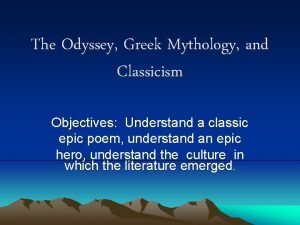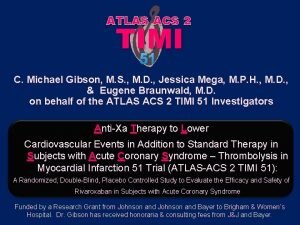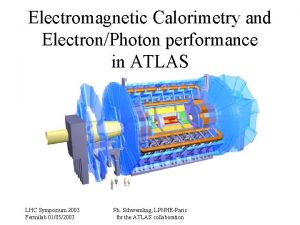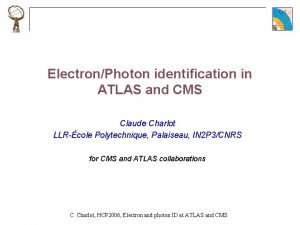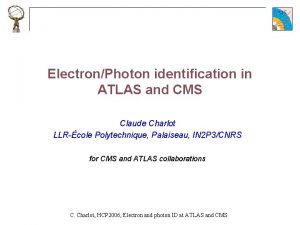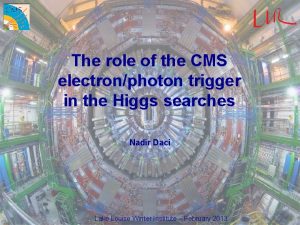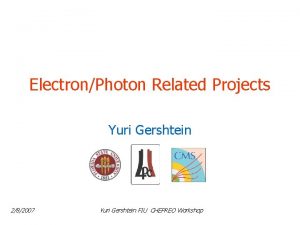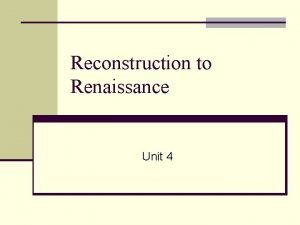A Summary of ElectronPhoton Reconstruction Performance in ATLAS















- Slides: 15

A Summary of Electron/Photon Reconstruction Performance in ATLAS Student Presentation for FAPPS 2008 @ Les Houches Bai Yu Wang Jin Arturo Sanchez

Outline Introduction to Electron/Photon Reconstruction p Energy Measurement p Electron reconstruction p Photon reconstruction p

Introduction Ø Importance – Final state with e orγ( ) Ø What to do – Isolated High Pt Ele/Photon : 1 – QCD background high pt Jet : ~105 Ø How to do – Information from EM calorimeter and ID are used – Electron • High Pt Electrons • Soft Electrons – Photon • Converted • Non Converted (Photon/jet separation) Ø Achievement - Performance

Energy Measurement Ø Effect in Energy Reconstruction – – Upstream Energy Loss Gaps between presampler Lateral leakage out of cluster Longitudinal leakage behind EM calorimeter Ø Energy Reconstruction Formula w 0 : correction for the upstream energy loss w 3 : correction for the energy leakage behind EM calorimeter

Energy Reconstruction : Performance Energy Deviation Energy Resolution

Electron Reconstruction Ø Electron/Jet Separation (High Pt Electron) Ø Electron/Pion Separation (Soft Electron)

Electron/Jet Separation: Performance Cuts R L 1 Trigger and HLT shower shape, Iso 91. 2± 0. 4% (1. 3± 0. 1)× 103 Cut on Track in ID 81. 3± 0. 5% ID-Calo Match 76. 4± 0. 6% (19. 5± 2. 5)× 103 (57± 7)× 103 TRT Cut ~70% ~105 Remove Conversion : Efficiency of Electron R : Rejection factor to the jets ~106

Electron/Pion Separation Ø Important for B-physics (B-tagging) Ø How to Reconstruct soft electron: – Track in ID with Pt>2 Ge. V – Hit by this track in EM calorimeter – Cuts based on shower shape estimator, E/P value, information from TRT

Electron/Pion Separation: Performance Pion Rejection as a function of electron identification efficiency for low energy electron

Photon Reconstruction Ø Converted Photon Reconstruction Ø Non Converted Photon Reconstruction

Converted Photon Reconstruction Ø Conversion is a frequent case for high pt photon(~40% in ) Ø Searched in ID Ø 3(η)× 7(Φ) window in EM calorimeter to reconstruct the Energy Ø Energy reconstruction via dependence of Et, conversion radius and photon energy

Non Converted Photon Reconstruction: Photon/Jet Separation • Photon/Jet Separation – Cuts on EM objects • L 1 Trigger, HLT, shower shapes, isolation – Cuts on EM-ID match • No Track in ± 0. 1×± 0. 1 (η× Φ) around cluster

Photon/jet Separation: Performace Jet rejection as a function of Et of jet for photon identification efficiency remains 80% at low and high luminosity

Conclusion Ø Powerful electron and photon identification algorithm developed – High identification efficiency – Very high QCD background rejection Ø These algorithm and ATLAS detector performance crucial for many discovery channels

Thank you
 Behaviorally anchored rating scales
Behaviorally anchored rating scales Performance management vs performance appraisal
Performance management vs performance appraisal Jcids manual 2018
Jcids manual 2018 Greek mythology objectives
Greek mythology objectives Stt atlas nusantara
Stt atlas nusantara Silvaco tcad
Silvaco tcad Atlas ti7
Atlas ti7 Noaa atlas rainfall data
Noaa atlas rainfall data Digital health atlas
Digital health atlas Atlas.ti for mac
Atlas.ti for mac Atlas player tracker
Atlas player tracker Atlas copco xc2002 sensor fail s unack
Atlas copco xc2002 sensor fail s unack Perkiraan informasi berdasarkan judul buku atlas dunia
Perkiraan informasi berdasarkan judul buku atlas dunia Atlas undp
Atlas undp Atlas acs
Atlas acs Atl transformation
Atl transformation



